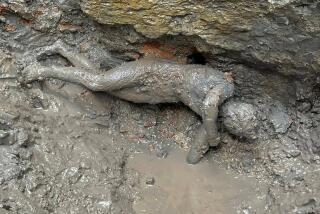Archeologists Lift Veil Hiding Rome’s Medieval Past
- Share via
ROME — Romans have long trooped through the little intersection while cutting through the narrow, twisting streets of the Old Ghetto neighborhood as a shortcut to the Piazza Venezia in the heart of downtown.
Just a few feet down lay a treasure--at least to archeologists, who have uncovered a trove of medieval artifacts in the last few months.
Findings from the excavation site in the popular tourist area off the Tiber River are helping document a period long given short shrift by academics more interested in shoveling down to the glories of Imperial Rome.
“We knew nothing of the Middle Ages here,” said Livia Casadei, brushing dust from the dig behind the Synagogue. “We knew only that there was a fish market. There was a great leap back to ancient times. We’re trying to fill the gap.”
Among the tidbits turning up from those forgotten times are oyster shells washed down a basin in a fishmonger’s shop a millennium ago.
The site edges into the ancient Portico d’Ottavia. Ottavia was the sister of Augustus who, from 27 BC to 23 BC, redid an existing portico in her honor as a splendid entrance to Marcellus’ Theater. The stone arena survives nearby, as do some of the portico’s 300 columns.
Paola Ciancio Rossetto, the supervising archeologist, said she knew she would find the podium that raised the portico above the street level of imperial days, which was a couple yards lower than today’s pavement. Indeed, excavations begun during work on underground sewer and utility lines exposed ancient underpinnings still partially covered with marble.
“But we also found scraps of history,” Ciancio Rossetto said, pointing to the foundations of medieval houses and the fish store’s travertine entrance step, worn down by Romans checking out the day’s catch. Shells indicate that at some point there were mussels and oysters for sale.
A fire scarred one side of the shop black, and curving in a stone wall probably indicates collapse.
“The shop must have gone out of business in a hurry,” Casadei said.
And the owner practiced recycling: Water pipes were stoppered by tops of pottery jars.
There is written mention of a fish market on the site in the 12th century, but fishmongers were probably working there at least two centuries earlier, archeologists say.
A church wedged between ancient columns is named St. Angelo in Pescheria--Italian for fish market--and a stone plaque outside the church instructs Romans to donate any fish over a certain size to the poor.
What surprised the excavators was how congested this corner of Rome was through the centuries. The market was jammed right into the edge of the portico’s ruins, and medieval houses were built so close that the street was barely wide enough for people to squeeze through.
The neighborhood stayed crowded when Pope Paul IV, in the middle of the Counter-Reformation in the 1550s, ordered Jews segregated in what became known as the Ghetto.
Today’s Romans live among the city’s ruins, just like the family in the medieval building whose first two stories use the portico’s walls. An ancient column divides kitchen from dining room, and a bedroom windowsill was fashioned from a carved sarcophagus.
Romans on bicycle or strolling past the trattoria on the sidewalk above stop and look down through a wire fence into the excavation as workmen wheel away loads of rubble.
Ciancio Rossetto said the archeologists are lobbying the city to leave the pit after the sewer work is completed so people can peer back through time.
“All the passersby stop and say: ‘It’s so nice. Leave it open,’ ” she said.
With Italy hard pressed to come up with the cash to protect the monuments and artifacts already excavated, archeologists have a tough time winning funds to open more digs.
So they eagerly jump into pits opened by construction and utility work.
A couple of blocks away, the same sewer work turned up a cluster of Renaissance-era Jewish temples thought destroyed in a fire. The Jewish community is lobbying for an underground passageway to be built so people will be able to view the temples when the utility project is over.
Not all sites win reprieves, however. In August, utility line work on the outskirts of Rome turned up a well preserved stretch of ancient Roman mosaic paving, but the city ordered the hole closed for lack of funds.
More to Read
Sign up for Essential California
The most important California stories and recommendations in your inbox every morning.
You may occasionally receive promotional content from the Los Angeles Times.













